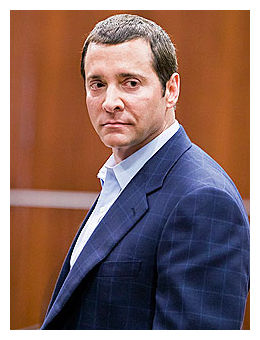
© Jack Kurtz/Associated PressJames Arthur Ray
When James Arthur Ray lifted the heavy tarp door and beckoned his devotees into a wood-frame dome, they obeyed. Tall and confident, Ray watched them enter one by one, more than 50 of them. Stooping under the low ceiling, they crowded into the dark, windowless space and sat in two tight rings around a pit filled with heated stones.
Many had spent more than $10,000 to be there, in what Ray called his "sweat lodge." It culminated five days with the self-proclaimed "catalyst for personal transformation" at Angel Valley Spiritual Retreat, a ranch near Sedona, Arizona. During his "Spiritual Warrior" program, he'd asked participants to shave their heads, spend 36 hours in the desert meditating without food or water, and play the "Samurai Game," in which a white-robed Ray, playing "God," declared people dead, forcing them to remain motionless on the ground.
Before they entered the dome, he warned them his final test was a symbolic death. "You are not going to die. You might think you are, but you are not going to die," he said, according to several attendees. Around 2:30PM on October 8th, 2009, he lowered the tarp, closing off the only source of light and oxygen. The ceremony began.
James Arthur Ray had gone from obscure motivational speaker to self-help superstar. After more than a decade of writing and lecturing, he'd appeared in
The Secret, a 2006 film touting "the law of attraction" - a belief that "thoughts become things." Positive thoughts attract positive outcomes,
The Secret promised; a dream life awaits anyone with a properly focused mind.
Oprah gushed over the film, twice showcasing its stars and telling her audience, "Watch it with your children."
The Secret became a cultural phenomenon; a companion book sold 19 million copies. Ray soon appeared on
Larry King Live to say, "Well, Larry, science tells us that every single thing that appears to be solid is actually energy. Your body is energy. Your car is energy, your house, everything, money, all of it is energy."
The Today Show, Fox Business News, and local network affiliates followed. He toured the country while guesting on smaller venues from Tom Green's internet talk show to
Coast to Coast AM with George Noory. He even judged a Miss America pageant. "Whatever you fear or love will come into your life," he'd repeat for his agreeable hosts.
But not everyone embraced
The Secret.
Newsweek called it "deplorable," with psychologist John Norcross condemning its "pseudoscientific, psychospiritual babble." Beneath its rosy view of a universe shaped by human will, critics noted a darker corollary: if your life was in shambles, that too resulted from the law of attraction. Negative thoughts produce negative outcomes, tragedy strikes those who somehow attract it, and the poor need more positive thinking. Dubious ethical questions aside, many commentators noted that
The Secret didn't actually present anything new. Instead,
it repackaged self-help nostrums as old as Ralph Waldo Emerson, using misleading quotations to bolster its claim to a historical lineage. (Winston Churchill, for example, was not a
Secret follower.)
Still, criticism didn't dissuade the millions who believed, and Ray's popularity rose alongside
The Secret. A smitten
2008 profile in Fortune magazine called him the "next big thing in the highly competitive world of motivational gurus," offering "a frothy concoction of spiritual wisdom, life lessons, and get-rich advice - all carefully attuned to today's fragile zeitgeist." He made no secret of his ambition, aiming to become the first self-help billionaire. He bragged about his financial success and promised it to his followers. He drew on esoterica from shamanism to quantum physics, but his most compelling support came in the form of Ray himself: tanned, confident, and rich.
So they followed him, into Angel Valley and into the darkness of a makeshift sweat lodge draped with tarps and blankets. And James Arthur Ray closed the door behind them.
Two and a half hours later, emergency responders arrived at what one
first took for a mass suicide, according to a witness. Many participants were dazed and disoriented, speaking or yelling deliriously. There was vomiting and crying; people frantically doused others with cold water. One man had fallen into the heated rocks, badly burning his arm. Medics performed CPR on at least three unconscious participants.
Kirby Brown had followed Ray into the lodge. Discovered there unconscious after the others had exited, she was dragged out with another group member, James Shore. Both died of heatstroke. A third member, Liz Neuman, slipped into a coma and died of organ failure nine days later. Eighteen others were hospitalized with burns and dehydration, kidney failure, breathing problems, and heat exhaustion.
The tragedy and ensuing prosecution drew international media attention. After a four-month trial, James Arthur Ray was found guilty of negligent homicide and sentenced to two years in prison. Now he's back on television, recently sitting down with Larry King's successor, Piers Morgan, for a one-hour solo interview.
From all appearances, James Arthur Ray intends to return to his self-help career.Kirby Brown's parents find that unacceptable. After suing Ray for negligence, fraud, and wrongful death, they shared with the other victims' families a $3 million settlement paid out of Ray's insurance. But that money comes second to preventing similar tragedies - the Browns want to fundamentally shift the self-help industry toward greater honesty, to hold practitioners accountable, and to help strivers like their daughter, as they put it, "seek safely." That means taking on Ray, calling out Oprah and other enabling media figures, and reforming an $11 billion self-improvement market.
"It's just terrible that our daughter had to die before we could see how dangerous someone like Ray really could be," says Kirby's mother, Ginny. "But this is bigger than James Ray. This is bigger than our daughter."
Yet another snake in a suit - a predator.